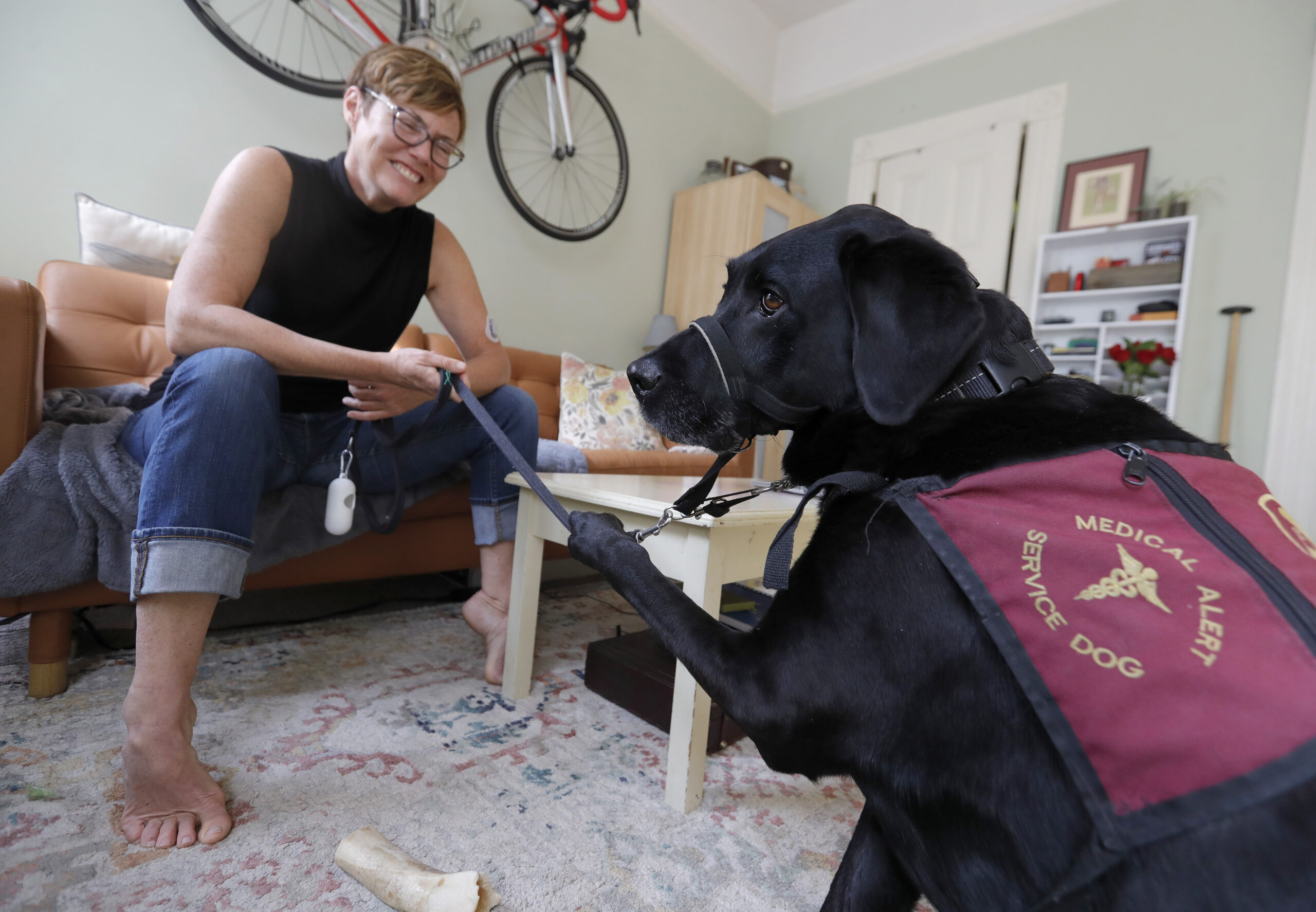As Kathleen Fraser sits curled up on her couch in her San Francisco apartment, describing the daily challenges of living with Type 1 diabetes, her black Labrador Ransom reaches up a paw and pats her knee.
Fraser and Ransom lock eyes, and she wonders if he’s alerting her to a sudden dip in her blood-sugar levels. From her front pocket, she pulls out her insulin pump, which is connected to a continuous glucose sensor on her arm and displays her blood-sugar levels on a small screen. She shows Ransom that her numbers are in a safe range. “It’s OK,” she says.
Reassured, Ransom returns to his spot on the floor. But if he continued to give her “that look” and started drooling, Fraser would worry that he sensed something her device hadn’t. He was trained by the Concord nonprofit Early Alert Canines to be persistent in alerting her anytime he sniffs chemicals in her body that signal a worrisome rise or drop in her blood-sugar .
Fraser is grateful that Ransom regularly nudges her to look at her pump or to check in with herself on how she’s feeling. One of the “vicious” 24/7 realities of Type 1 diabetes is that it’s often hard to predict when a potentially life-threatening shift in blood-sugar levels will occur.
Reassured, Ransom returns to his spot on the floor. But if he continued to give her “that look” and started drooling, Fraser would worry that he sensed something her device hadn’t. He was trained by the Concord nonprofit Early Alert Canines to be persistent in alerting her anytime he sniffs chemicals in her body that signal a worrisome rise or drop in her blood-sugar .
Fraser is grateful that Ransom regularly nudges her to look at her pump or to check in with herself on how she’s feeling. One of the “vicious” 24/7 realities of Type 1 diabetes is that it’s often hard to predict when a potentially life-threatening shift in blood-sugar levels will occur.
The technology for monitoring diabetics’ glucose levels continues to improve. But even with the most high-tech gear, Fraser feels better having Ransom around. Ali Dugger, another EAC client, who lives in Santa Barbara, feels the same way about her golden Labrador Dixie. Bringing Dixie into her life was a huge commitment, but she says Dixie is better at sniffing out changes in her glucose levels than her devices.
These changes are too subtle for humans to smell, but it’s been said that dogs, with their superior sense of smell, have the ability to detect odors at concentrations of around one part per trillion, the equivalent of detecting a teaspoon of sugar in two Olympic sized swimming pools.
Dugger has experienced Dixie’s olfactory gifts whenever she’s had her at the local pool where she swim laps. Even while Dugger is in the water, dozens of feet away, Dixie has alerted her to plummeting glucose levels. Dixie also saved her in a crisis one New Year’s Eve. While Dugger didn’t drink, she had skipped dinner, returned to her hotel and suffered a steep drop in her glucose levels while asleep. Dixie couldn’t rouse her. But as trained, Dixie alerted the person with her, who woke up and called 911.
Carol Edwards founded EAC after previously raising puppies for Guide Dogs for the Blind, some of whom weren’t temperamentally suited to working with people who have impaired vision. She was part of a project to assess the possibility of training these dogs to alert diabetics when they have hypoglycemia.
“When the body knows there is a blood-sugar problem, it dumps a bunch of chemicals to try and counteract that,” Edwards said. “(In a diabetic) those chemicals begin to circulate around the body and are emitted in sweat, the person’s breath or skin.”
The exact chemical cocktail that dogs detect is not known, but a recently placed EAC dog can alert a new client with 60% accuracy. As the client and dog live together, that rate increases to 90%; Edwards described how a client and dog also become like a devoted married couple who can communicate with a look or gesture.
To create this bond, EAC carefully vets clients, asking detailed questions about their health and lifestyle. Dugger said she knew she had to trust EAC to find the right dog for her, one that could go with her to the pool, but who also was a “snuggle bug.”
When Dugger first laid eyes on Dixie in 2019, “I had a sudden feeling, I’m not alone in all this. I felt this instant connection. It brought tears to my eyes. It was one of the most joyous moments in my life.”
